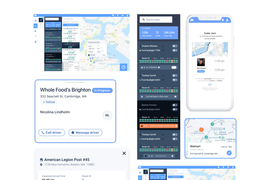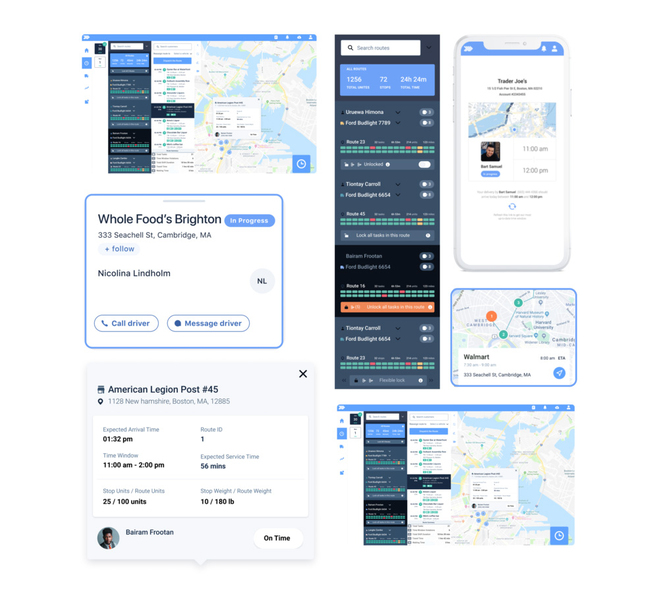More and more people are doing their shopping from home these days, and whether they’re ordering groceries, home office equipment, or Covid-19 tests, they increasingly expect their deliveries to be fast and on time.
Companies have struggled to keep up with the rise in orders and expectations. One of their biggest challenges is optimizing the so-called last mile of delivery — when a driver takes packages from a regional hub to their final destination.
Now Wise Systems, a startup that began as a class project at MIT, is offering a dispatch and routing platform designed to make the last-mile delivery experience better for everyone, from drivers to dispatchers to customers.
Wise Systems’ routing solution is built on algorithms and machine learning models that continually improve as they gather more data. The company’s web app, meanwhile, gives a high level of visibility into fleet operations in real time. The mobile app also leverages an often-underappreciated asset in the industry: the drivers on the ground. It enables them to make notes on unique stops, communicate with dispatchers, and confirm deliveries.
“Drivers, regardless of the technology they use, are very, very knowledgeable about every one of their stops and every one of those parts of town, so we believe in harnessing their knowledge to make their experience better,” says Vice President of Customer Experience Layla Shaikley SM ’13, who co-founded Wise Systems with CEO Chazz Sims ’13, SM ’14; CTO Ali Kamil ’16; and COO Jemel Derbali.
The founders began working on Wise Systems in 2014 but say they’ve felt the sense of urgency among customers increase during the pandemic.
“Ultimately what we’re interested in is the perfect delivery experience,” Shaikley says. “What that really means is something that’s predictable, cost-effective, and automated for the people using the product.”
A class project worth pursuing
The founders met in the 2014 Development Ventures class at MIT’s Media Lab, a course that challenges students to come up with ideas that have the potential to impact a billion lives. With the MIT Center for Transportation and Logistics (CTL), they began exploring ways to use machine learning and data to improve last-mile delivery.
That summer the founders entered the delta v accelerator hosted by the Martin Trust Center for MIT Entrepreneurship, where they were introduced to companies who would help them hold their first pilots. Delta v was one of several ways MIT helped the founders early on.
“What resource didn’t we use at MIT?” Shaikley jokes. “We applied for every award. I won the Caroll Wilson award; Ali got a transportation scholarship as a graduate student; we did every pitch competition; we were involved in the MIT $100K Entrepreneurship Competition. We definitely used every resource possible. We walked into professor Edward Blanco’s office one day and said, ‘We’re starting a company, can you advise us?’ He said, ‘Absolutely.’ To this day, the network is so supportive. We were also in [the MIT Startup Exchange’s] STEX25 startup accelerator. Doors are always opening for us.”
Kamil also thinks the culture at MIT helped give the founders confidence early on.
“Being at MIT, there’s a sense that we can challenge the status quo, and that helped us have that confidence to challenge companies that have been around for 25 years,” Kamil says. “That’s the mentality that was instilled in us at MIT and that still drives our ambition to change the industry and be the operating system that powers the last mile of every kind of delivery.”
Another thing that gave the founders confidence was the sorry state of information systems many logistics companies were still using to plan routes and communicate with drivers.
“In terms of the previous systems, I’ve seen everything from phone books and printed out manuals to outdated apps on tablets that were built into the vehicle,” Shaikley says. “Some phone apps, but apps that neglected to optimize the user experience or the needs of the drivers.”
The founders say companies would often plan routes based solely on truck capacity without considering other factors like traffic, fuel, historic delivery times, and driver shift length — all of which are baked into Wise Systems’ algorithms. Wise Systems has also incorporated operations research from MIT’s CTL and built machine learning models that continue optimizing delivery plans, providing the order of each delivery for drivers and rearranging that order to ensure on-time arrivals.
Beyond routing, the founders wanted their system to be easy to use, particularly for new drivers because of the high turnover in the industry. To build that system, they began by riding with drivers during shifts to better understand their needs and how they interact with their app.
“We have a two-pronged approach to tech development,” Ali explains. “The [AI] technology is there, but it has to be coupled with good design, because you have drivers who are trying to do their job — and they’re trying to do it fast. They don’t want the tech to be cumbersome. That was something we had to learn in the field.”
Today Wise Systems’ platform allows for easy communication between drivers and dispatchers. Drivers can use the mobile app for navigation, to collect signatures, take photos, scan barcodes, and to access notes on specific spots. Dispatchers can make sure deliveries are occurring on time and make updates to schedules in real time. All of that information is documented to give companies a better understanding of fleet performance.
Continuing to learn
Wise Systems is currently working with large courier companies that operate around the world as well as retailers and multinational food and beverage distributors like Anheuser-Busch. Earlier this year, Wise Systems partnered with Mitsubishi Fuso Truck and Bus Corp. to improve last mile delivery in Japan, and it recently opened an office in that country.
The founders say customers using the company’s system have reached new highs in fleet utilization and in the percentage of deliveries made on time. Wise Systems also doubled in size during the pandemic as companies adopted an online-first model.
Even with the success, the founders remain committed to learning from their customers in a scrappy, boots-on-the-ground fashion more typical of an early-stage startup. Just last month Shaikley hopped in a delivery truck with a driver, as eager to learn about the driver experience as she was at MIT.
“We want to make sure we’re in front of the industry,” Shaikley says. “We want to continue to build the simplest, smartest technology, and continue to improve it as the industry grows.”












